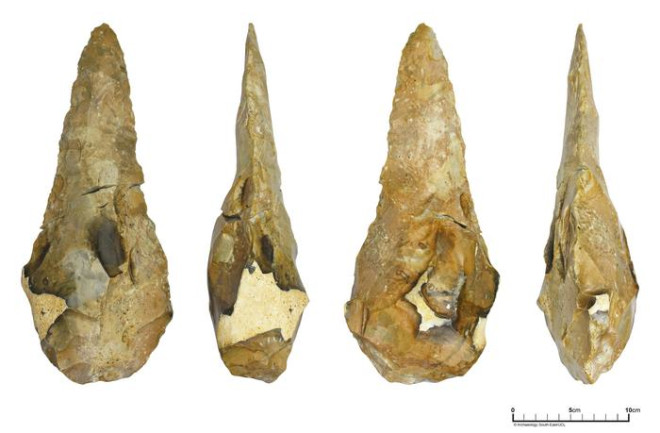In 2021, a team of archaeologists led by the University College of London (UCL) Institute of Archaeology dug deep trenches into the gravelly soil of a site southeast of London. Their routine job was to check the land before workers built the Maritime Academy secondary school, but the work became more and more exciting as they excavated.
From the 3-meter-deep trenches, they collected some 800 different stone artifacts thought to be over 300,000 years old – so old that they couldn’t say for sure which early human species had used them. At that point in time, Neanderthals were spreading throughout present-day England, and other species may have joined them, the new paper says.
Read More: What Types of Tools Did Neanderthals Use and Develop?
Why Craft Such a Large Tool?
Most striking of all the tools was a massive hand axe, a triangular instrument normally used for butchering animals and cutting meat. But in this case, the “ficron” was so large and unwieldy (11.6 inches) that the researchers could only guess at its original purpose. Had Neanderthals used it as a kind of sport to test strength? As a kind of cutting tool that was placed on the ground? Or, did the ficron hold ceremonial significance for the early humans?
“These hand axes are so big it’s difficult to imagine how they could have been easily held and used,” says Letty Ingrey, a UCL archaeologist, in a press release. “While right now, we aren’t sure why such large tools were being made, or which species of early human were making them, this site offers a chance to answer these exciting questions.”
The team hopes that a more detailed analysis of all 800 artifacts will reveal more about the ficron and the early humans who used it. Living during the Last Ice Age, they would have lived on wooded hills, alongside straight-tusked elephants, red deer, lions and horses.
The Great Hand Axe Rankings
English archaeologists have maintained a contest over the years for the largest ficron ever discovered, as described in the 1987 paper “The Great Giant Handaxe Stakes.” The latest find shakes up the ranking, taking over the third slot, a ways behind the 12.7-inch ficron that has held the number one slot since 1919.
For whatever reason, excavations have tended to uncover ficrons from the Thames and the nearby Medway River areas, which is what happened in 2021. The researchers found the new ficron in what was once a tributary of the Medway, inside sand and gravel that had accumulated in the waterway.
“The excavations at the Maritime Academy have given us an incredibly valuable opportunity to study how an entire Ice Age landscape developed over a quarter of a million years ago,” says Matt Pope, a UCL archaeologist, in a press release. “A program of scientific analysis, involving specialists from UCL and other U.K. institutions, will now help us to understand why the site was important to ancient people.”
Read More: The Earliest Modern Humans Mastered Bow Hunting 54,000 Years Ago

